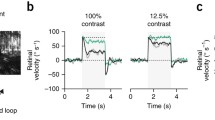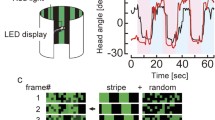Abstract
In the neural superposition eye of a dipteran fly every ommatidium has eight photoreceptors, each associated with a rhabdomere, two central and six peripheral, which altogether result in seven functional light guides. Groups of eight rhabdomeres in neighboring ommatidia have largely overlapping fields of view. Based on the hypothesis that the light signals collected by these rhabdomeres can be used individually, we investigated the feasibility of estimating 3D scene information. According to Pick (Biol Cybern 26:215–224, 1977) the visual axes of these rhabdomeres are not parallel, but converge to a point 3–6 mm in front of the cornea. Such a structure theoretically could estimate depth in a very simple way by assuming that locally the image intensity is well approximated by a linear function of the spatial coordinates. Using the measurements of Pick (Biol Cybern 26:215–224, 1977) we performed simulation experiments to find whether this is practically possible. Our results indicate that depth estimation at small distances (up to about 1.5–2 cm) is reasonably accurate. This would allow the insect to obtain at least an ordinal spatial layout of its operational space when walking.
Similar content being viewed by others
References
Adelson E, Bergen J (1991) The plenoptic function and the elements of early vision. In: Computational models of visual processing. MIT, Cambridge, pp 3–20
Anderson JC, Laughlin SB (2000) Photoreceptor performance and the co-ordination of achromatic and chromatic inputs in the fly visual system. Vis Res 40:13–31
Barlow H (1964). The physical limits of visual discrimination. In: Giese A (eds). Photophysiology. Academic, New York, pp. 163–202
Bausenwein B, Dittrich AP, Fischbach KF (1992) The optic lobe of Drosophila melanogaster. II Sorting of retinotopic pathways in the medulla. Cell Tissue Res 267:17–28
Bolles RC, Baker HH, Marimont DH (1987) Epipolar-plane image analysis: an approach to determining structure from motion. Int J Comp Vis 1:7–55
Braitenberg V (1967) Patterns of projection in the visual system of the fly. Exp Brain Res 3:271–298
Brodský T, Fermüller C, Aloimonos Y (1999) Shape from video. Proc IEEE Conf Comput Vis Pattern Recognit 2:146–151
Campos-Ortega J, Strausfeld N (1972) The columnar organisation of the second synaptic region of the visual system of Musca domestica. Z Zellforschung 124:561–585
Dahmen H, Wüst RM, Zeil J (1997). Extracting egomotion parameters from optic flow: Principal limits for animals and machines. In: Srinivasan MV, Vekatesh S (eds). From living eyes to seeing machines. Oxford University, Oxford, pp. 174–198
Dawkins R (1996) Climbing mount improbable. Norton, New York
Fermüller C, Aloimonos Y (2000) Observability of 3D motion. Int J Comput Vis 37:43–63
Franceschini N (1975). Sampling of the visual environment by the compound eye of the fly. In: Snyder AW, Menzel R (eds). Photoreceptor optics. Springer, Berlin Heidelberg New York, pp. 98–125
Gortler S, Grzeszczuk R, Cohen RSM (1996) The lumigraph. ACM SIGGRAPH, pp 43–54
Götz K (1964) Optomotorische Untersuchung des visuellen Systems einiger Augenmutanten der Fruchtfliege Drosophila. Kybernetik 2:77–92
van Hateren JH (1984) Waveguide theory applied to optically measured angular sensitivities of fly photoreceptors. J Comp Phys A 154:761–771
van Hateren JH, van der Schaaf A (1998) Independent component filters of natural images compared with simple cells in primary visual cortex. Proc R Soc Lond B 265:359–366
Hecht-Nielsen R (1987) Counterpropagation networks. Appl Optics 26:4979–4984
Hecht-Nielsen R (1988) Applications of counterpropagation networks. Neural Netw 1:131–139
Horn BKP (1986) Robot vision. McGraw Hill, New York
Kirschfeld K (1967) Die Projektion der optischen Umwelt auf das Raster der Rhabdomere im Komplexauge von Musca. Exp Brain Res 3:248–270
Kirschfeld K (1976). The resolution of lens and compound eyes. In: Zettler Z, Weiler R (eds). Neural principles in vision. Springer, Berlin Heidelberg New York, pp. 354–370
Kohonen T (2000) Self-organizing maps. Springer, Berlin Heidelberg New York
Land M (1981). Optics and vision in invertebrates. In: Autrum H (eds). Comparative physiology and evolution of vision in invertebrates. Handbook of sensory physiology, vol VII/6B. Springer, Berlin Heidelberg New York, pp. 471–592
Laughlin SB (1981). Neural principles in the peripheral visual systems of invertebrates. In: Autrum H (eds). Comparative physiology and evolution of vision in invertebrates. Handbook of physiology, vol VII/6B. Springer, Berlin Heidelberg New York, pp. 133–280
Levoy M, Hanrahan P (1996) Light field rendering. ACM SIGGRAPH, pp 161–170
Neumann J, Fermüller C (2003) Plenoptic video geometry. Vis Comput 19:395–404
Neumann J, Fermüller C, Aloimonos Y (2004) A hierarchy of 3D photography. Comput Vis Image Underst 96:274–293
Pick B (1977) Specific misalignments of rhabdomere visual axes in the neural superposition eye of dipteral flies. Biol Cybern 26:215–224
Reichardt W (1969). Movement perception in insects. In: Reichardt W (eds). Processing of optical data by organisms and by machines. Academic, New York
Rossel S (1983) Binocular stereopsis in an insect. Nature 301: 821–822
Simoncelli EP, Olshausen BA (2001) Natural image statistics and neural representation. Annu Rev Neurosci 24:1193–1216
Srinivasan MV, Lehrer M, Zhang SW, Horridge GA (1989) How honeybees measure their distance from objects of unknown size. J Comp Physiol A 165:605–613
Srinivasan MV, Zhang SW, Altwein M, Tautz J (2000) Honeybee navigation: nature and calibration of the ‘odometer’. Science 287:851–853
Stavenga DG (2003a) Angular and spectral sensitivity of fly photoreceptors. I. Integrated facet lens and rhabdomere optics. J Comp Physiol A 189:1–17
Stavenga DG (2003b) Angular and spectral sensitivity of fly photoreceptors. II. Dependence on facet lens F-number and rhabdomere type in Drosophila. J Comp Physiol A 189:189–202
Stavenga DG (2004a) Angular and spectral sensitivity of fly photoreceptors. III. Dependence on the pupil mechanism in the blowfly Calliphora. J Comp Physiol A 190:115–129
Stavenga DG (2004b) Visual acuity of fly photoreceptors in natural conditions-dependence on UV sensitizing pigment and light-controlling pupil. J Exp Biol 207:1703–1713
Strausfeld NJ (1984). Functional neuroanatomy of the blowfly’s visual system. In: Ali MA (eds). Photoreception and vision in invertebrates. Plenum Press, New York, pp. 483–522
Strausfeld NJ (1989). Beneath the compound eye: neuroanatomical analysis and physiological correlates in the study of insect vision. In: Stavenga DG, Hardie RC (eds). Facets of vision. Springer, Berlin Heidelberg Newyork, pp. 317–359
Strausfeld NJ, Lee JK (1966) Neuronal basis for parallel visual processing in the fly. Vis Neurosci 7:13–33
Trujillo-Cenoz O, Melamed J (1966). Electron microscope observations on the peripheral and intermediate retinas of dipterans. In: Bernard CG (eds). The functional organization of the compound eye. Pergamon Press, Oxford, pp. 339–361
Author information
Authors and Affiliations
Corresponding author
Rights and permissions
About this article
Cite this article
Bitsakos, K., Fermüller, C. Depth estimation using the compound eye of dipteran flies. Biol Cybern 95, 487–501 (2006). https://doi.org/10.1007/s00422-006-0097-1
Received:
Accepted:
Published:
Issue Date:
DOI: https://doi.org/10.1007/s00422-006-0097-1




